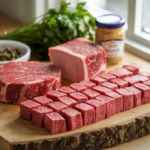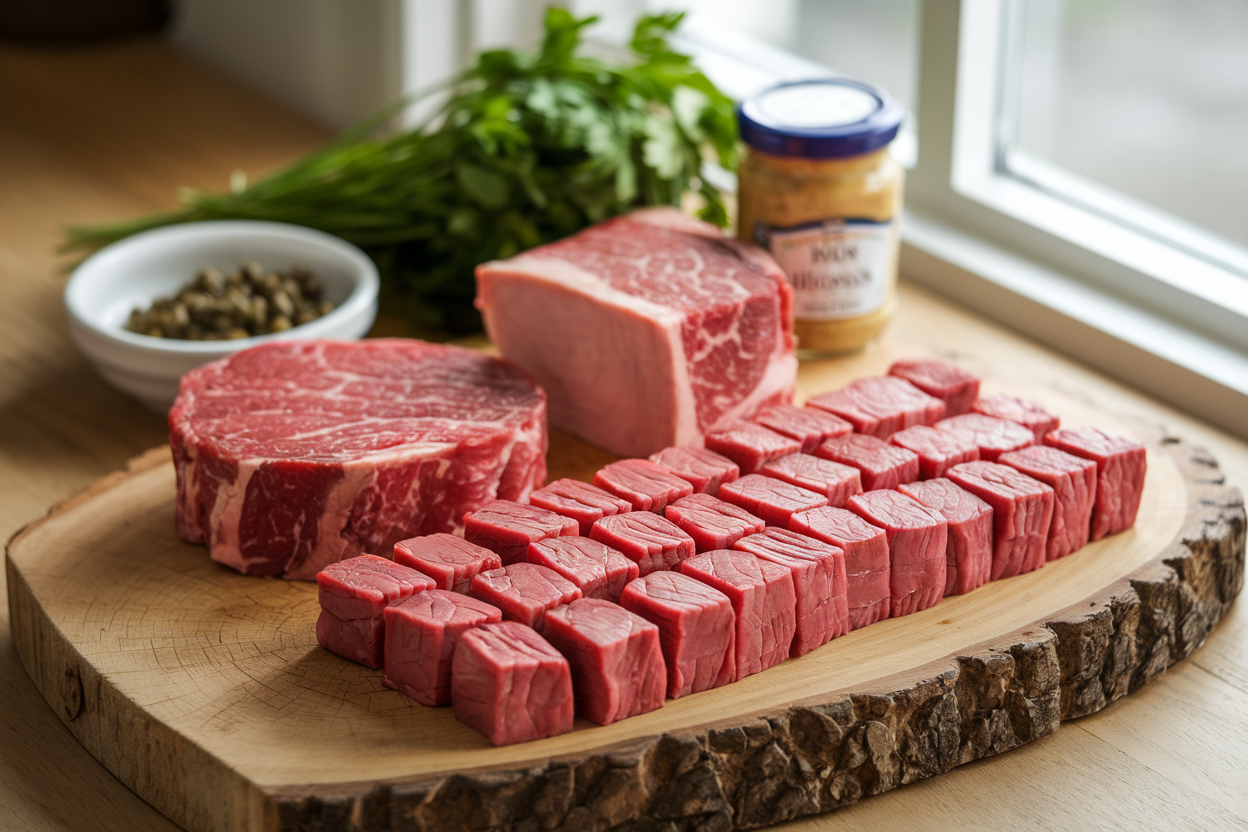Beef tartare is a dish that requires precision, care, and the highest quality ingredients. When preparing a meal centered on raw beef, the meat selection becomes the most crucial aspect. So, what kind of meat is used for beef tartare? In this article, we’ll dive deep into the best cuts of beef for tartare, explore preparation techniques, and offer tips to ensure your tartare is both delicious and safe. Whether you’re a seasoned chef or a home cook, this guide will equip you with everything you need to make the perfect beef tartare.
Before we begin, if you’re interested in exploring other hearty beef recipes, check out our Ultimate Beefaroni Recipe for a comforting, easy-to-make dish that the whole family will love.

Understanding Beef Tartare: What You Need to Know
Beef tartare, often referred to as steak tartare, is a culinary classic enjoyed for centuries. Typically served as an appetizer, this dish is made from finely chopped or ground raw beef, seasoned with various ingredients like capers, mustard, and herbs. The key to an exceptional tartare lies in the quality and type of beef used.
What Is Beef Tartare?
At its core, beef tartare consists of raw beef, but not just any beef will do. The meat must be of the highest quality, typically sourced from a trusted butcher who understands the importance of freshness. The best cuts for tartare are lean, tender, and free from sinew or fat.
The History and Popularity of Beef Tartare
Beef tartare has roots in European cuisine, particularly in France, where it has long been a staple in bistros and fine dining establishments. Over time, it has gained popularity worldwide, becoming a favorite among food enthusiasts who appreciate the delicate balance of flavors and textures.
If you’re looking to add a tangy twist to your dishes, consider trying our Pickle de Gallo recipe. It’s a unique take on salsa that pairs beautifully with a variety of meals, including beef dishes like tartare.
The Importance of Meat Quality in Beef Tartare
Why Meat Quality Matters
When preparing beef tartare, meat quality is non-negotiable. Since you consume the beef raw, it must be free from contaminants and handled with the utmost care. High-quality beef not only ensures a better flavor and texture but also reduces the risk of foodborne illnesses.
The Risks of Low-Quality Meat
Using low-quality or improperly handled meat can lead to serious health risks. Contaminants like bacteria and parasites thrive in raw meat, making it essential to select beef that is fresh and sourced from a reputable supplier. You should never use pre-ground beef from the supermarket for tartare, as it can harbor harmful bacteria.
And if you’re in the mood for something sweet after your tartare, don’t miss our Ultimate Guide to Pumpkin Bars. It’s the perfect dessert to round off a rich and savory meal like beef tartare.

Recommended Cuts of Beef for Tartare
The Best Beef for Tartare: A Guide to Cuts
Not all cuts of beef are suitable for tartare. You need to choose cuts that are tender and lean, with minimal fat or sinew. Here are some of the best options:
- Beef Tenderloin: This is the most popular cut for tartare due to its tenderness and delicate flavor. It’s the same cut used for filet mignon, making it a premium choice.
- Filet Mignon: Known for its buttery texture, filet mignon is a top-tier option for tartare. Its fine grain makes it easy to chop finely, resulting in a smooth, melt-in-your-mouth tartare.
- Eye of Round: A lean cut often used in dishes requiring thin slicing, eye of round is another excellent choice for tartare. It’s affordable and offers a good balance between flavor and texture.
- Top Sirloin: For those looking for a more economical option, top sirloin provides a slightly firmer texture but still delivers on flavor.
- Rib Eye: While not as lean as other cuts, rib eye offers a rich flavor that some chefs prefer for tartare. It requires careful trimming to remove excess fat.
- Flat Iron: An alternative cut that is both tender and flavorful, flat iron is gaining popularity in tartare preparations.
Grass-Fed vs. Grain-Fed Beef: Which Is Better?
The debate between grass-fed and grain-fed beef often centers on flavor and nutritional differences. Grass-fed beef tends to have a more pronounced, earthy flavor and is leaner, which can influence the taste and texture of your tartare. On the other hand, grain-fed beef is often more tender and has a slightly sweeter flavor, making it a matter of personal preference.
How to Choose the Best Meat for Tartare
Tips for Selecting Beef at the Butcher
When shopping for beef tartare, it’s important to communicate your needs to the butcher. Here are some tips:
- Ask for Fresh Cuts: Let your butcher know you’ll be using the beef for tartare, so they can provide the freshest cuts available.
- Check the Color: The beef should be bright red with no discoloration. Avoid meat with a brownish hue.
- Smell the Meat: Fresh beef should have a clean, neutral smell. Any off odors could indicate spoilage.
Freezing Meat for Tartare: Pros and Cons
Some chefs recommend freezing beef for a short period before preparing tartare. This technique can help reduce the presence of microorganisms and makes the meat easier to chop. However, freezing can also affect the texture, making it slightly firmer. It’s important to strike a balance—freeze the meat just long enough to firm it up without compromising its tenderness.
Preparing Beef for Tartare at Home
Proper Trimming and Cleaning Techniques
Before preparing your tartare, it’s crucial to trim the beef properly. Remove any fat, sinew, or connective tissue, as these can be tough and unappetizing when raw. Use a sharp knife to achieve clean cuts and ensure the meat is as tender as possible.
Hand Chopping vs. Grinding
For the best texture, hand chopping is preferred over grinding. Grinding can cause the meat to become too fine, resulting in a mushy tartare. By hand chopping, you have more control over the size of the pieces, allowing for a more pleasant mouthfeel.
Achieving the Perfect Dice for Tartare
The ideal size for beef tartare is small, even cubes that are roughly 1/8 inch in size. This ensures that the beef is easy to chew and allows the seasonings to distribute evenly throughout the dish.
Enhancing the Flavor of Beef Tartare
Traditional Flavorings for Tartare
Beef tartare is typically seasoned with a variety of ingredients that enhance its natural flavor:
- Capers: These small, pickled buds add a burst of acidity that balances the richness of the beef.
- Dijon Mustard: Mustard provides a sharp, tangy contrast that complements the beef.
- Worcestershire Sauce: A few dashes of this sauce add depth and umami to the tartare.
- Herbs: Fresh herbs like parsley or chives can add a bright, fresh flavor.
The Role of Acidity in Beef Tartare
Acidity is key to balancing the richness of raw beef. Ingredients like lemon juice or vinegar can help cut through the fat and enhance the overall flavor profile of the dish. Be cautious not to overdo it—too much acidity can overpower the beef.
Serving Suggestions for Beef Tartare
Beef tartare is traditionally served with toasted bread, crackers, or a simple green salad. These accompaniments add texture and help balance the flavors of the dish. For a modern twist, consider serving tartare with thinly sliced radishes or pickled vegetables.
FAQs About Beef Tartare
What Cut of Beef Is Used for Tartare?
The most common cuts of beef used for tartare include beef tenderloin, filet mignon, eye of round, and top sirloin. These cuts are chosen for their tenderness and lean composition.
Can I Use Grocery Store Beef for Tartare?
It’s generally not recommended to use pre-packaged grocery store beef for tartare, as it may not be fresh enough or have been handled properly. Always opt for high-quality, fresh beef from a trusted butcher.
What Meat Is Safe for Tartare?
The safest meat for tartare is fresh beef that has been properly handled and stored. It should be free from contaminants and sourced from a reputable supplier.
What Ground Beef for Tartare?
While some might be tempted to use ground beef for tartare, it’s safer and more flavorful to hand-chop or freshly grind your own meat. This minimizes the risk of bacterial contamination and ensures a better texture.
Related Topics and Variations
Regional Variations of Beef Tartare
While beef tartare is most commonly associated with French cuisine, variations of the dish can be found worldwide. For example:
- Korean Yukhoe: A similar dish made with raw beef, seasoned with soy sauce, sesame oil, and Asian pears.
- Italian Battuta di Manzo: A variation that uses finely chopped beef seasoned with olive oil, lemon, and truffle.
Nutritional Profile of Beef Tartare
Beef tartare is high in protein and contains essential nutrients like iron, zinc, and B vitamins. However, because it’s raw, it’s important to be mindful of the potential risks associated with consuming raw meat.
Common Mistakes When Making Beef Tartare
- Using the Wrong Cut of Meat: Not all beef cuts are suitable for tartare. Stick to tender, lean cuts like tenderloin or filet mignon.
- Over-Seasoning: It’s easy to go overboard with seasonings, which can overpower the delicate flavor of the beef.
- Improper Handling: Always keep the meat cold and work quickly to reduce the risk of contamination.
The Role of Beef Tartare in Fine Dining
In fine dining, beef tartare is often served as an appetizer, showcasing the chef’s skill in selecting and preparing high-quality ingredients. It’s a dish that appeals to culinary enthusiasts who appreciate the nuances of flavor and texture that raw beef can offer.
Conclusion
Selecting the right kind of meat for beef tartare is the key to creating a dish that is both flavorful and safe. By choosing high-quality cuts like beef tenderloin, filet mignon, or eye of round, and following proper preparation techniques, you can enjoy a perfect tartare every time. Remember to always prioritize freshness and handle the meat with care. With this guide, you’re well-equipped to make a beef tartare that will impress any guest.
Print
Beef Tartare
- Total Time: 15 minutes
- Yield: 2 servings
- Diet: Paleo, Keto
Description
A classic dish made from high-quality raw beef, seasoned with capers, mustard, and herbs for a delicious appetizer.
Ingredients
- Beef Tenderloin or Filet Mignon (or other recommended cuts)
- Capers
- Dijon Mustard
- Worcestershire Sauce
- Fresh herbs (parsley, chives)
- Lemon juice (or vinegar)
- Salt and pepper to taste
- Toasted bread or crackers (for serving)
Instructions
- Start with high-quality beef from your butcher and ensure it’s fresh.
- Trim any fat, sinew, or connective tissue from the meat.
- Hand chop the beef into small, even cubes (about 1/8 inch).
- In a mixing bowl, combine the chopped beef with capers, mustard, Worcestershire sauce, and herbs.
- Add lemon juice, salt, and pepper to taste.
- Mix gently to combine all ingredients without overworking the meat.
- Serve immediately with toasted bread or crackers.
Notes
Always prioritize meat quality and freshness when preparing beef tartare. Proper handling is crucial to ensure safety.
- Prep Time: 15 minutes
- Cook Time: 0 minutes
- Category: Appetizer
- Method: Raw preparation
- Cuisine: French
Nutrition
- Serving Size: 1 serving
- Calories: 250
- Sugar: 1g
- Sodium: 350mg
- Fat: 15g
- Saturated Fat: 6g
- Unsaturated Fat: 7g
- Trans Fat: 0g
- Carbohydrates: 2g
- Fiber: 0g
- Protein: 24g
- Cholesterol: 75mg
Keywords: beef tartare, raw beef, appetizer, classic dish, gourmet

